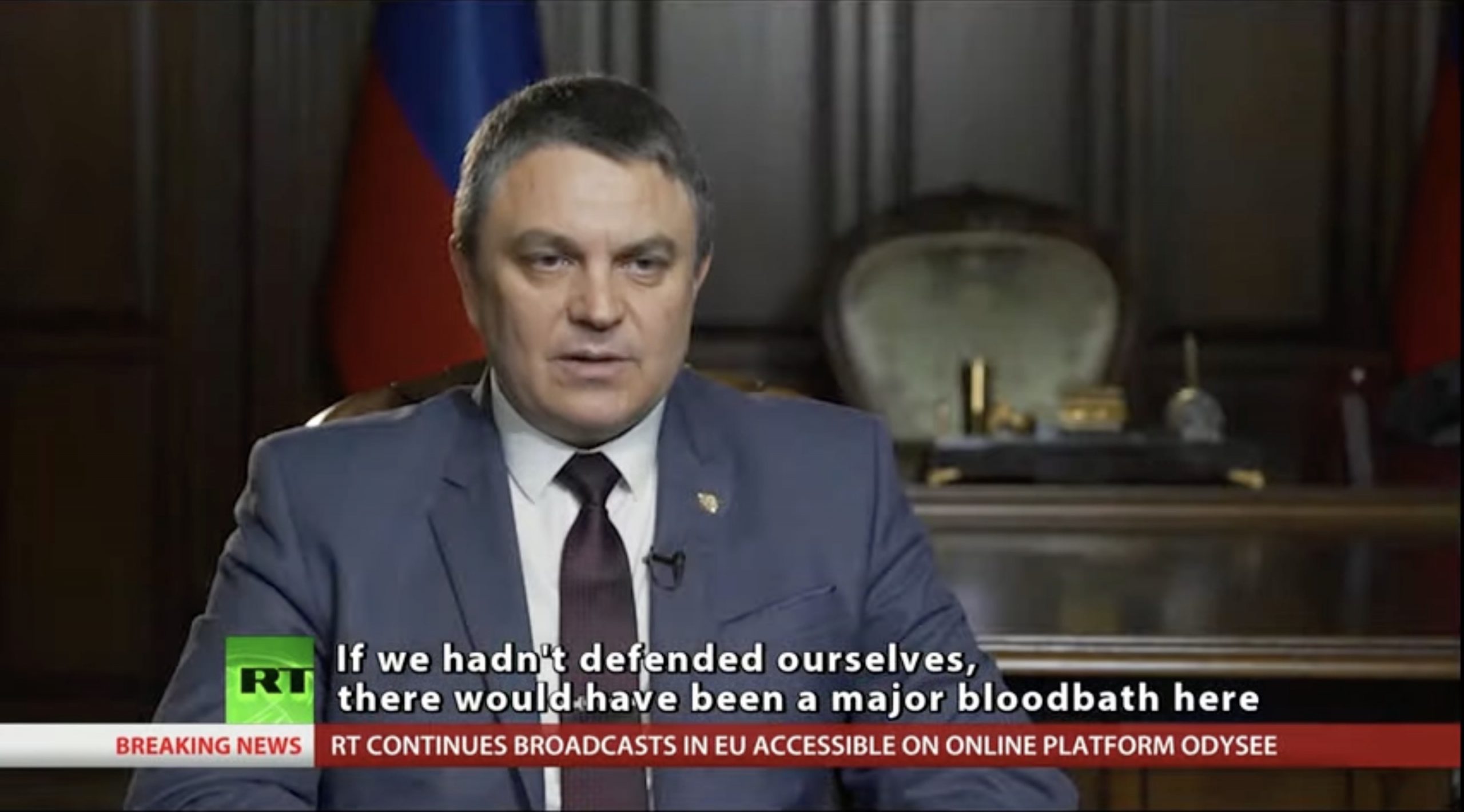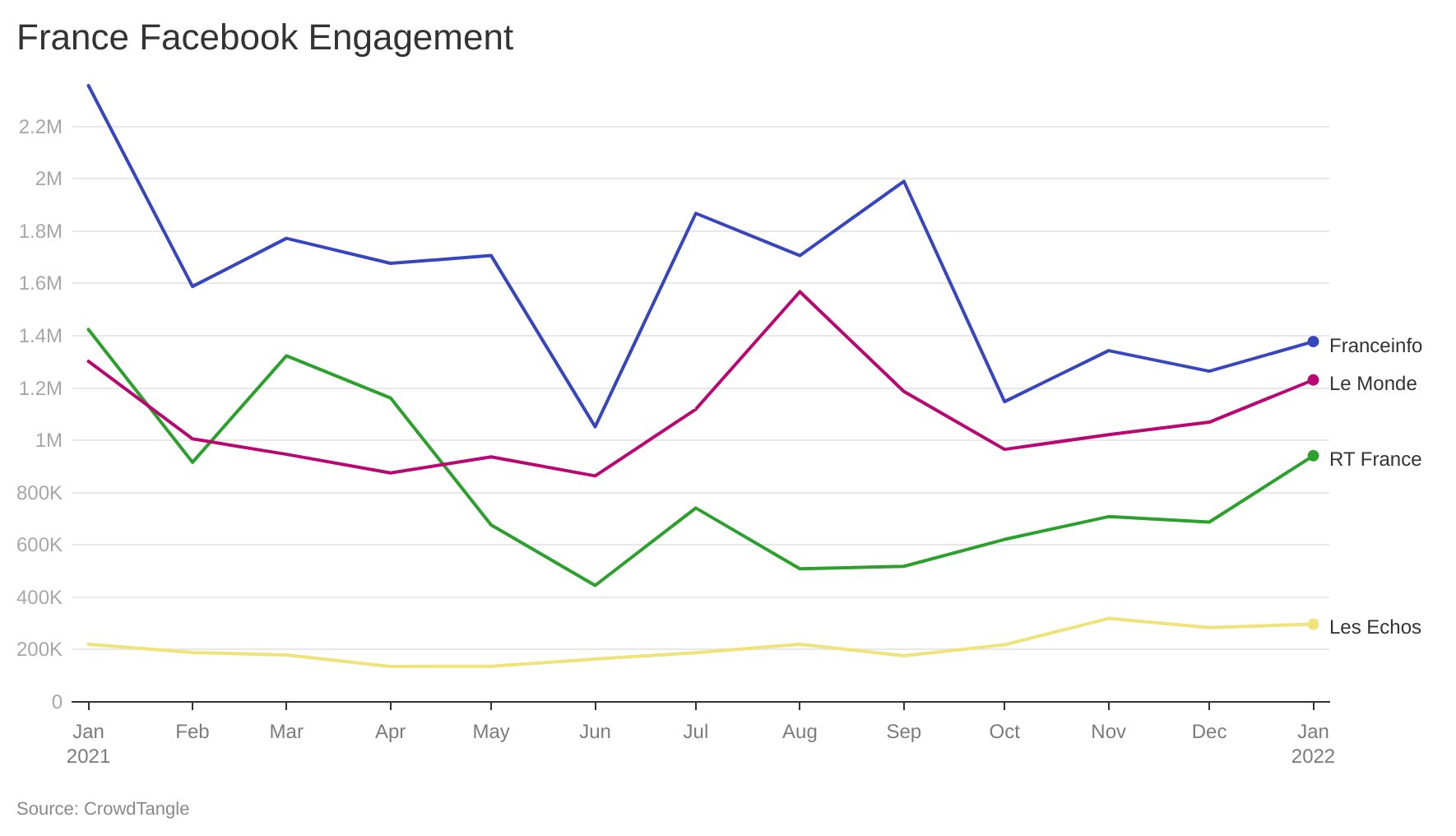
Is RT’s international audience real?
That’s an important question, as regulators and distributors debate where the Kremlin-backed network falls on the spectrum from news channel to state propaganda. All across the world, RT is being tossed off cable systems, blocked by ad networks, removed from app stores, downranked in search engines, or banned outright.But the level of concern would seem inextricably linked to the size of RT’s reach; propaganda isn’t particularly effective if no one sees it. Is it a rising power in an information war, or a waste of Kremlin cash that fakes its own numbers?
Today, Oxford’s Rasmus Kleis Nielsen compiled some data on RT’s online reach in the U.K., France, and Germany and the takeaway seems to be: not great on the web, but surprisingly strong on social media, at least in spots. You can see his thread here, but here are a few highlights.
The share of each country’s online population that sees RT content in a typical month is small: 0.6% in the U.K., 2.0% in France, and 3.0% in Germany. In the U.K., that means RT is barely a blip; both the BBC and The Guardian reach roughly 73× as many Britons.

But the story’s a little more nuanced in France and Germany, where the news audience is more fractured, without a central anchor like a BBC. In France, RT’s 2% reach means it’s not that much smaller than national newspapers Les Echoes (2.8× RT’s audience) or Le Monde (7.3× RT’s audience). In Germany, RT is within shouting distance of Der Spiegel (just 1.6× RT’s audience) and not that far behind public broadcaster ARD (4.9× RT’s audience).


Things look tighter on social media. In the U.K., RT’s monthly Facebook engagements (reactions, comments, and shares) are still well behind the BBC (which gets roughly 14× RT’s number), but it’s not far behind The Guardian (roughly 1.5× RT).

In France and Germany, though, RT is a legitimate national player on Facebook. It’s well ahead of Les Echoes, and Le Monde’s lead is only about 30%. And in Germany — hold onto deine Mütze — RT was the No. 1 news source in terms of engagements on Facebook in both December and January, according to this CrowdTangle data. (Or at least it was ahead of the major German news publishers; we’ve asked Facebook for comment and will update this post if we hear back.)


This pattern — RT as a news source that not many people actively seek out, but that knows how to push the right buttons to succeed on Facebook — is a lot like what we’ve seen over the past decade from sites that push misinformation, conspiracy theories, and culture-war content. It’s not a happy pattern.
The size of RT’s audience has been a matter of debate for as long as it’s existed. Back in 2015, The Daily Beast reported that RT “hugely exaggerates its viewership,” citing leaked documents:
The Daily Beast obtained these documents from Vasily Gatov, a former RIA Novosti employee who had a hand in their preparation. He says they were meant for top Kremlin officials. “Since RT’s earliest days, something always looked wrong to me,” Gatov said. “RT persistently pretended that it was much more important and much bigger than could be confirmed by any data. While RT’s internal reporting told their commissioner — the Russian government — that they’d managed to overcome CNN and the BBC in terms of viewership, no signs of this could be found in reliable data, audited and vetted by foreign sources. Their social media growth, reported in every public statement by RT as a ‘phenomenon,’ also looked suspicious.”
(Another useful reminder that something like Facebook interactions are subject to significant fakery.)
RT makes big claims about its YouTube audience, but only about 1% of the videos it posts there are political in nature. Its big YouTube hits? “Videos of natural disasters, accidents, crime, and natural phenomenon.”
In the U.S., one useful datapoint is that the cable systems that have carried RT nearly all did so because RT was paying them or because of a loophole in federal regulations that required them to. (The loophole was later closed.) If the market demand for RT was significant, the Kremlin wouldn’t have to pay off American companies to carry it.
There’ve also been a number of academic studies on RT’s audience. One of my favorites is this one from 2020 by Rhys Crilley, Marie Gillespie, Bertie Vidgen, and Alistair Willis:
Through a data-driven application of network science and other computational methods, we address this gap to provide insight into the demographics and interests of RT’s Twitter followers, as well as how they engage with RT…First, we find that most of RT’s Twitter followers only very rarely engage with its content and tend to be exposed to RT’s content alongside other mainstream news channels. This indicates that RT is not a central part of their online news media environment.
Second, using probabilistic computational methods, we show that followers of RT are slightly more likely to be older and male than average Twitter users, and they are far more likely to be bots.
Identifying bots is not a perfect science, but they found that 39% of RT’s Twitter followers were likely bots, as opposed to the 1.5% it found in a random sample of Twitter users.
I’m not sure how much anyone can say with confidence about RT’s actual reach. I think it’s telling that most of the best “evidence” of a big audience — social media engagements, follower counts, YouTube views, its own press releases — originates on platforms where the data is easiest to manipulate. That pushes me to the skeptical side of the debate, at least when it comes to the United States. But the internet has taught us over and over that reach and influence are two related but distinct things. RT doesn’t need a huge audience to be influential — only the right one.